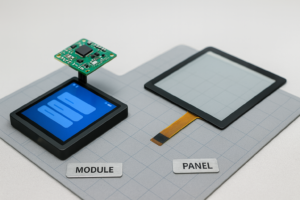Alt Text: Rugged outdoor touch screen display with high-brightness technology operating in direct sunlight at a transportation hub
Today, the world is witnessing a growing trend of outdoor touch displays in city centers and industrial sites. These touch screen displays experience harsh sunlight, rain, or temperature extremes that indoor screens never had to. Standard displays are often not made to handle glare or weather. Special outdoor touch displays remain usable in bright sunlight, rain, or severe weather where a standard display would not be useful.
An outdoor display can solve an everyday need, such as a transport schedule that must be seen at noon or a kiosk that works in the rain. The secret is sunlight-readable technology and high-brightness features that keep information visible and interactions running smoothly outdoors.
Keep reading!
Why Standard Displays Fail Outdoors.
Regular indoor touch screen displays do not work outdoors as they are not designed to do so. The sun, turning weather and being bumped will cause most normal screens to give up the ghost when used outdoors.
Sunlight Makes Screens Unreadable.
Sunlight glare is the main issue for standard displays outside. In bright sunlight, most indoor screens are not visible because of their brightness levels below 500 nits. Even if you’re able to see the display, the glass surface reflects and obstruct content in this way. This problem with glare makes typical touch screen displays useless for outdoor visibility applications.
Weather Damages Internal Components.
Alterações de temperatura e humidade estragam os ecrãs interiores usados do lado de fora. When it’s hot in summer, the screens stop working due to overheating. When it’s cold in winter, the screen response time slows down. Rain and humidity get through to housings without protection. Over time, dust and dirt build up on screens and in the devices, scratching surfaces and blocking cooling fans. If screens are not made for outdoor use, they get spoilt easily.
Physical Stress Causes Early Failure.
Outdoor setups get jostled, shaken up, and vandalized, unlike indoor screens. The glass in standard displays cracks from little impacts, and the plastic frames warp in the sun. Touch screen sensors fail to work if exposed to extreme temperatures. Frequent vibration in transport applications causes connectors to loosen. Common touch screen displays become faulty due to conditions such as temperature and vibration.
This is why outdoor touch displays are made; indoor displays do not work outdoors. These displays come with brighter screens and weatherproof construction. In addition, they have rugged designs to resist physical stress. When companies use ordinary displays painted out, they have to keep replacing them because they break down often, and their users get miffed.
Sunlight Readable Touch Displays: Core Features.
Displays are able to support touch through specialised engineering, which enables touchable displays to help in containing context. The displays use many technologies to provide clarity and functionality under bright sunlight.
High Brightness Output for Outdoor Visibility.
Sunlight-readable touch displays begin at 1000 nits brightness, with premiums hitting 2500 nits or above. This brightness is higher than sunlight that would wash out standard displays. Due to the high brightness, the content would not wash out in sunshine where normal displays would.
Advanced Optical Treatments Reduce Glare.
An anti-glare coating on the glass surface scatters the light reflected back, and an anti-reflective coating minimizes reflections from the surface itself. Thanks to optical enhancement, screen visibility improves from a variety of angles. These treatments keep images sharp and reduce strain on people using their screens in bright light.
Optical Bonding Eliminates Visual Distortion.
The bonding eliminates the air gaps between the various display layers that would cause refraction. This tech prevents humidity from happening between layers due to humidity. Standard displays create a layering effect due to trapped air that causes light scattering and visual interference.
Enhanced Contrast Ratios Maintain Clarity.
A high contrast ratio ensures that the text and graphic are distinct from the background. This becomes especially important as the sunlight gets stronger and weaker throughout the day. The enhanced contrast makes it easier to read from early morning to the afternoon and evening.
These features help us make displays that work really well in terms of reliability outdoors. A combination of features such as high brightness, glare reduction, optical bonding, and enhanced contrast allows the display to be usable where other displays have become completely unreadable. The engineering in sunlight-readable touch displays makes them the only realistic option for outdoor applications where visibility is important.
High-Brightness Touch Displays: Technology and Performance.
Displays that can be seen in sunlight often solve visibility issues. However, high-brightness touch displays use additional technologies to ensure performance. These devices enable operation under conditions where sustained high-brightness output poses challenges.
LED Backlighting for Superior Performance.
Modern high-brightness touch displays use LED technology rather than LCD technology. Unlike LCDs, LEDs provide backlight illumination, giving more uniform illumination over the entire display surface while using less power. When operating at above 1,000 nits for prolonged periods, this efficiency becomes critical. The way LED lights shine makes colors more vivid than other options while also saving energy.
Thermal Regulation Systems.
Because high brightness operations generate much heat one must cool chip. These displays have heat sinks, air channels, and sometimes things like fans, to keep them from overheating. Thermal design prevents performance throttling and prolongs the life of display components when used in hot outdoor conditions.
Adaptive Brightness Control.
Modern ambient light sensors can adjust brightness based on surroundings. Simple regulation keeps things bright while saving energy when things are dim. The introduction of an auto brightness control system to sunlight detection and a power-saving system will control the brightness of our system according to sunlight, and the brightness of the system will decrease automatically in sunlight.
UV Protection for Longevity.
UV-degradation-resistant materials are essential for outdoor applications. Premium high-brightness touch screens use glass and plastic materials that won’t yellow or get brittle over time. This protection enables optical clarity and touch sensitivity after years of out-of-doors exposure, as opposed to which quickly fade when exposed to sunlight.
These advances work together so that displays can maintain consistent high brightness in harsh outdoor conditions and be long-term functional. The use of efficient lighting, thermal management, adaptive controls, and durable materials makes modern high-brightness touch displays suitable for permanent outdoor installation.
Durability and Environmental Protection.
Outdoor touch displays must be protected from the elements. These specific screens come equipped with different features for working in tougher conditions.
Ingress Protection Against Elements.
IP65 waterproof touch panels are entirely dust-proof and resist low-pressure water jets from any angle. For more demanding conditions, IP68 waterproof touchscreens can withstand temporary immersion, and IP69K-rated devices can withstand high-pressure washdowns. This guarantees protection in rain, dust, or rigorous cleaning.
Wide Temperature Operation.
Reliable outdoor touch displays can work between very high temperatures of 70 degrees Celsius and down to -30 degrees Celsius. Special components and thermal management systems have been used to avoid freezing in winter cold and overheating in summer heat. This temperature tolerance helps provide reliable results in different climates and seasons.
Vandal-Resistant Construction.
Tempered glass is used in devices, making their surfaces resistant to scratches and impact from accidental or intentional abuse due to its 7H hardness. Structural strength against physical stress is offered due to aluminium or stainless steel reinforced frames. These features make the screens perfect for high-traffic public setups where toughness matters.
Chemical and Corrosion Resistance.
Heavy-duty materials help the corrosive elements in harsh conditions. Coastal uses need coatings to resist saltwater, and factory settings require oil and solvent resistance. These chemical-resistant characteristics help prolong display life in difficult operating settings.
Key Applications of Outdoor Touch Displays.
Outdoor touch displays are important to various industries as they offer reliable interactive options in challenging environments. These specialized screens are tough and useful for different operations.
Public Information and Wayfinding Systems.
Cities and institutions utilize outdoor touch displays in kiosks to provide information to visitors. The outdoor touch displays are maps, directions, and local points of interest with easy-to-use user interaction. They are designed to operate in adverse weather conditions, such as rain, sun, and other weather and environmental conditions, at which ordinary displays will not work.
Retail and Advertising Solutions.
Places like malls and parks use touch screens, which are high-brightness displays. The screens, which can be destroyed outdoors, can still be seen in bright sunlight. Consumers are engaged by them more than by standard signage.
Industrial Control Interfaces.
Factories and processing plants depend on tough touch-screen displays for operating and monitoring equipment. These industrial versions are designed to withstand dust, moisture, and temperature extremes while being easy to read. Employees can handle machines and get information while wearing gloves under tough plant conditions.
Transportation Management Systems.
You can find outdoor touch displays set up at bus terminals, train stations, and airports for schedules, alerts. The screens are readable in all weather conditions and are built for heavy usage in public. Travelers can access real-time updates and get help in planning routes with touch.
Every application enjoys the mix of strength and performance offered by modern outdoor touch displays. From enabling tourists to find their way in cities to ensuring that industrial processes run smoothly, these specialised screens are becoming ubiquitous outdoors.
Conclusion: Investing in the Right Outdoor Solution.
Touch displays that are readable in the sunlight and high-brightness touch displays solve visibility challenges. The right solution suite ensures your outdoor solution’s durability, visibility and touch functionality. Specialised features ensure dependable performance, whether glare-free screens for digital signage or tough panels for industrial work are what you require.
For tailored solutions, including optical bonding and capacitive touch technology, consult experts like Ever Glory Ltd. These businesses’ skills help companies select and implement perfect outdoor touch displays that can withstand environmental stresses while providing users with excellent experiences. When you choose quality displays, you invest wisely to help you avoid expensive replacement costs in the future.
.png)



